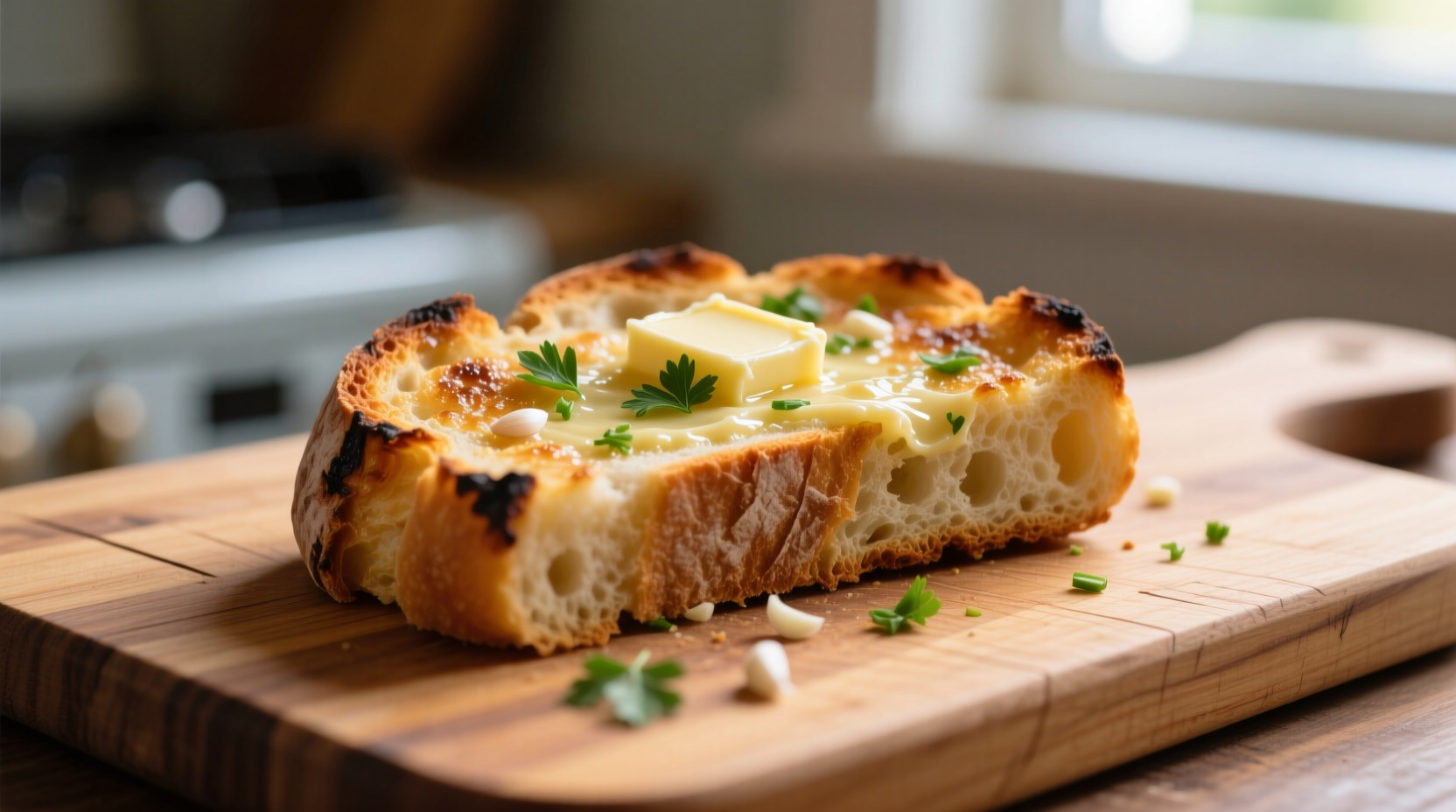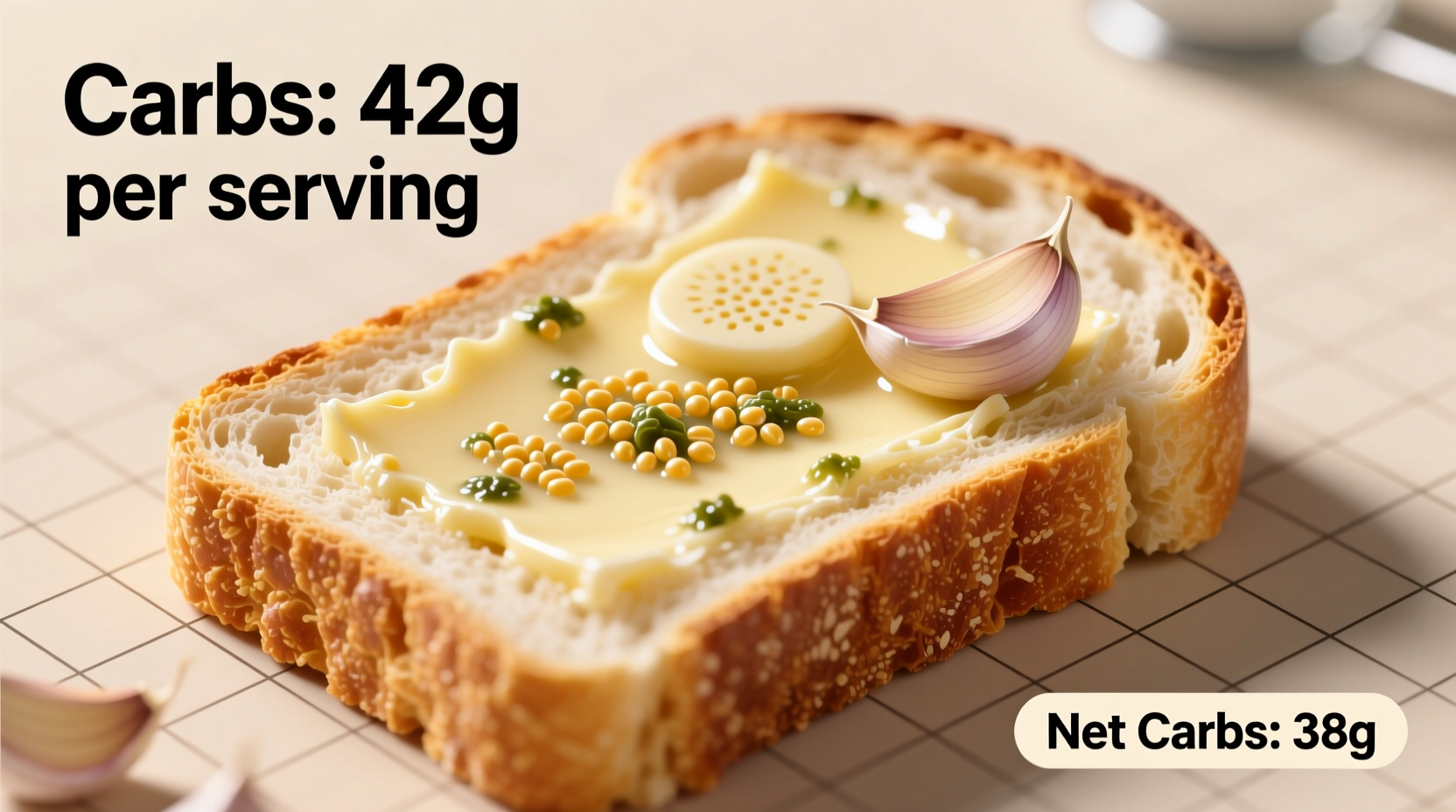One standard slice (57g) of frozen garlic bread contains approximately 25 grams of total carbohydrates, with 23 grams of net carbs. Homemade versions typically range from 20-30g total carbs per slice depending on ingredients and preparation method. This represents about 8-10% of a standard 2,000-calorie daily carb allowance.
Understanding the carbohydrate content in garlic bread is essential for anyone tracking their nutritional intake, whether you're managing diabetes, following a specific diet plan, or simply making more informed food choices. This guide breaks down exactly what's in your favorite cheesy, buttery indulgence and how it fits into various eating patterns.
What You're Really Eating: Garlic Bread Composition
Garlic bread's carb content primarily comes from its foundation—bread. The type of bread used dramatically affects the final carbohydrate count. Traditional French or Italian baguette-based garlic bread contains more complex carbohydrates than versions made with enriched doughs.
According to USDA FoodData Central, the basic components contributing to carbs in garlic bread include:
| Ingredient | Carb Contribution per Serving | Notes |
|---|---|---|
| White bread base (1 slice) | 15-20g | Primary carb source; varies by recipe |
| Garlic butter spread | 1-3g | Minimal carbs unless sugar added |
| Cheese topping (if used) | 0-1g | Negligible carb contribution |
| Additional seasonings | 1-3g | May include sugar in some commercial versions |
Commercial frozen garlic bread often contains added sugars and preservatives that increase the carb count compared to homemade versions. Always check nutrition labels for the most accurate information specific to your product.
How Garlic Bread Compares to Other Bread Options
When evaluating garlic bread's place in your diet, context matters. Here's how it stacks up against other common bread products:
| Bread Type | Total Carbs (per 57g slice) | Net Carbs | Fiber Content |
|---|---|---|---|
| Garlic bread (frozen) | 25g | 23g | 2g |
| Plain white bread | 15g | 14g | 1g |
| Whole wheat bread | 17g | 14g | 3g |
| Sourdough bread | 16g | 15g | 1g |
| Ciabatta | 20g | 19g | 1g |
The additional carbohydrates in garlic bread compared to plain bread come primarily from added ingredients in the garlic spread and any cheese toppings. Some commercial varieties include sugar in the butter mixture to enhance browning and flavor.
Practical Guidance for Different Dietary Needs
Your approach to garlic bread should align with your specific nutritional goals. Understanding context boundaries helps make informed decisions without unnecessary restriction.
For standard balanced diets: A single slice of garlic bread fits comfortably within daily carbohydrate recommendations. The American Diabetes Association suggests 45-60g of carbs per meal for most adults, making garlic bread a reasonable occasional side dish.
For low-carb or keto diets: Traditional garlic bread exceeds typical daily carb limits (20-50g). However, strategic modifications can create acceptable versions. Using low-carb bread alternatives and focusing on high-fat components can reduce net carbs to 5-10g per serving.
For diabetes management: Pair garlic bread with protein and fiber-rich foods to moderate blood sugar response. The American Diabetes Association recommends balancing carbohydrate intake with medication and activity levels.
Smart Modifications for Lower-Carb Enjoyment
You don't need to eliminate garlic bread entirely from your diet. These practical adjustments maintain flavor while reducing carbohydrate impact:
- Portion control: Enjoy half a slice (28g) for approximately 12-15g total carbs
- Bread selection: Choose thinner slices or baguette ends which contain fewer carbs per serving
- Homemade advantage: Control ingredients by using high-protein or low-carb bread bases
- Flavor concentration: Maximize garlic and herb flavors to satisfy with smaller portions
For those following strict low-carb protocols, consider these alternatives that deliver similar flavor profiles with significantly reduced carbs:
- Garlic buttered zucchini slices
- Cheesy garlic cauliflower toast
- Eggplant "bread" with roasted garlic
- Mushroom caps with garlic herb butter

Reading Labels: What to Watch For
Commercial garlic bread products vary widely in nutritional content. When evaluating options, pay attention to these often-overlooked details:
- Serving size discrepancies: Some brands list nutrition facts for "1/2 slice" while others use full slices
- Added sugars: Check for hidden sugars in the garlic butter mixture (often listed as dextrose or maltodextrin)
- Fiber content: Higher fiber versions can reduce net carb count
- Enriched flours: Products using enriched wheat flour may have higher glycemic impact
The FDA requires standardized nutrition labeling, but preparation methods significantly affect final carb content. Restaurant garlic bread can contain 30-40g of carbs per serving—nearly double typical frozen varieties—due to generous butter and oil usage.
Historical Context: How Garlic Bread Has Evolved
Traditional Italian bruschetta, the precursor to modern garlic bread, was originally a peasant food designed to use stale bread. The evolution timeline reveals important nutritional shifts:
- Pre-1940s: Simple preparation with olive oil, garlic, and stale bread—minimal added carbs
- 1950-1970s: Americanized versions added butter and cheese, increasing fat but not significantly altering carb content
- 1980s-present: Commercial production introduced preservatives and sugar to enhance shelf life and flavor
- Current trends: Growing demand for healthier options has spurred lower-carb and whole-grain commercial varieties
This historical perspective helps explain why modern garlic bread often contains more carbohydrates than its traditional counterpart. The addition of sugar in commercial preparations—uncommon in authentic Italian recipes—contributes to higher carb counts in many store-bought versions.
Practical Planning: Incorporating Garlic Bread Wisely
Garlic bread can fit into most eating patterns when approached strategically. Consider these evidence-based recommendations from the Academy of Nutrition and Dietetics:
- Balance your meal by pairing garlic bread with protein-rich main dishes and non-starchy vegetables
- Choose versions with visible garlic pieces rather than garlic powder, which often indicates added fillers
- Opt for freshly prepared garlic bread when dining out, as it's less likely to contain added sugars
- Track your total meal carbs rather than focusing on single items
Remember that occasional indulgence in traditional garlic bread won't derail a generally healthy eating pattern. The key is mindful consumption and understanding how it fits within your overall nutritional strategy.











 浙公网安备
33010002000092号
浙公网安备
33010002000092号 浙B2-20120091-4
浙B2-20120091-4